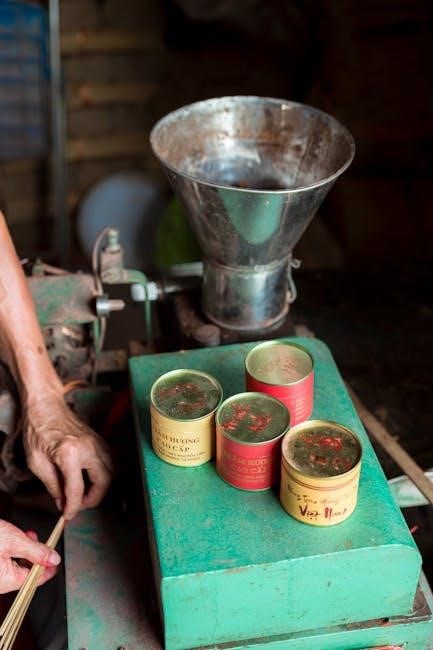
Coffee grinding is the cornerstone of coffee preparation‚ transforming beans into a brew. Proper grind size ensures optimal extraction‚ balancing flavors and aromas for a perfect cup.
Why Grinding Your Own Coffee Matters
Grinding your own coffee ensures freshness‚ as pre-ground beans lose flavor quickly. Customizable grind sizes suit various brewing methods‚ enhancing extraction and taste. It allows experimentation with roast levels and origins‚ offering control over aroma and flavor. Investing in a grinder fosters a deeper connection to coffee‚ making each brew personal. Plus‚ it’s cost-effective in the long run compared to buying pre-ground coffee. With the right grinder‚ you can elevate your coffee game‚ ensuring every sip is tailored to your preferences‚ whether it’s a rich espresso or a smooth pour-over.
Understanding Coffee Grinders
Coffee grinders are essential tools for transforming whole beans into precise grinds. They come in blade or burr types‚ each offering unique benefits for flavor and consistency.
Types of Coffee Grinders: Blade vs. Burr
Blade grinders use spinning blades to chop beans‚ often leading to uneven grinds and heat damage. Burr grinders‚ with abrasive surfaces‚ crush beans consistently and preserve flavor. Blade grinders are affordable but less precise‚ while burr grinders offer superior control‚ making them ideal for enthusiasts. Choose burr grinders for consistent results and better extraction in brewing methods like espresso or pour-over. This distinction is key to understanding grinder performance and its impact on coffee quality.
Key Features to Look for in a Coffee Grinder
When selecting a coffee grinder‚ prioritize features that enhance performance and convenience. Burr type is crucial—steel or ceramic burrs offer durability and consistent grinding. Adjustable grind settings allow customization for various brewing methods. Look for a grinder with a large bean capacity to reduce refills. Durable build quality‚ such as stainless steel or high-grade plastic‚ ensures longevity. Additional features like a built-in scale‚ timer‚ or smart app integration can streamline your brewing process. Easy cleaning and maintenance options are also essential for optimal functionality over time.
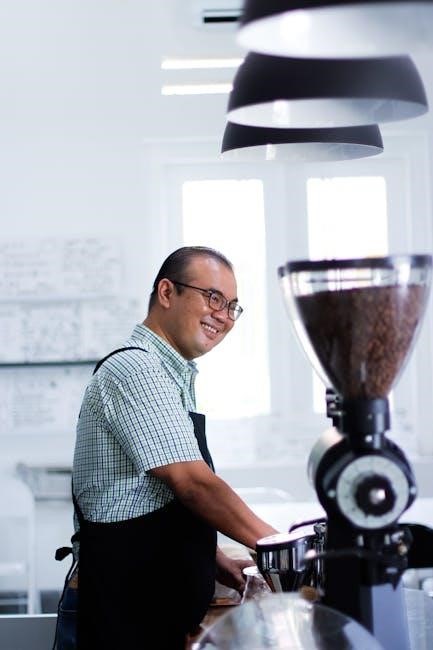
The Basics of Coffee Grinding
The foundation of great coffee lies in proper grinding. It releases flavors and oils‚ with grind size determining extraction. Regular cleaning and fresh beans ensure best results.
How to Choose the Right Grind Size for Your Brew
Selecting the appropriate grind size is crucial for achieving optimal extraction in various brewing methods. Espresso requires a fine grind for quick‚ pressurized extraction‚ while French press needs a coarse grind to prevent over-extraction during steeping. Pour-over methods typically use a medium to fine grind for balanced flavor. Consider factors like bean freshness‚ roast level‚ and grinder type—burr grinders offer consistency. Experimentation may be necessary to perfect the grind for your specific equipment and brewing technique‚ ensuring a flavorful cup every time.
The Importance of Consistency in Grinding
Consistency in grinding is crucial for achieving balanced extraction and flavor in coffee. Inconsistent grinds can lead to over- or under-extraction‚ resulting in bitter or sour notes. Blade grinders often cause irregular particles‚ while burr grinders ensure uniformity. Regular calibration and maintenance of your grinder are essential to maintain precision. Proper techniques‚ like pre-infusion and timing‚ further enhance consistency. By mastering consistent grinding‚ you can elevate the quality of your brew and enjoy a more flavorful cup every time.
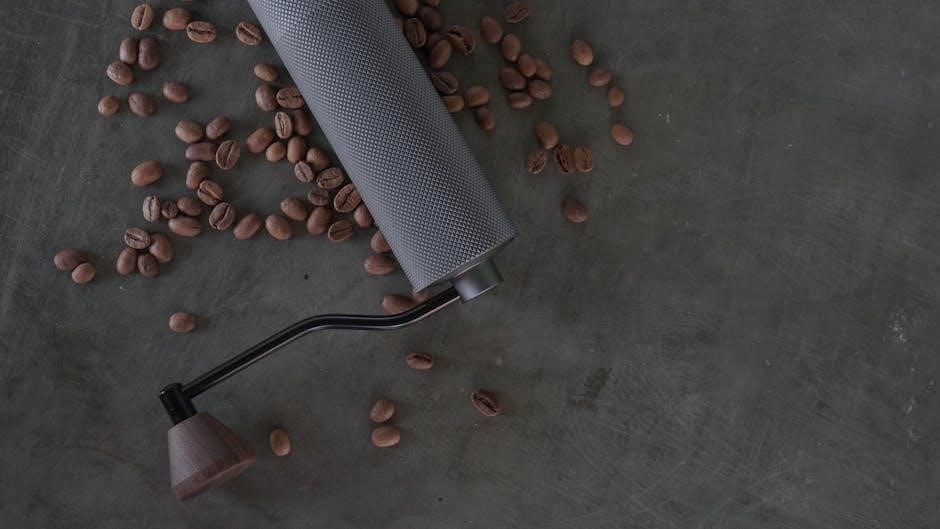
Grind Size and Its Impact on Flavor
Grind size directly influences extraction‚ affecting flavor. Fine grinds can lead to over-extraction‚ while coarse grinds result in under-extraction‚ impacting aroma and taste balance.
How Grind Size Affects Extraction
Grind size significantly impacts coffee extraction‚ as it determines the surface area exposed to water. A finer grind increases extraction potential but risks over-extraction‚ leading to bitterness. Coarser grinds reduce extraction‚ possibly resulting in under-extracted‚ weak coffee. The optimal grind size balances flavor compounds‚ ensuring a harmonious brew. Adjusting the grind allowstailoring extraction to specific brewing methods‚ such as espresso or pour-over. Proper calibration is essential for achieving the perfect balance of acidity‚ sweetness‚ and body in your coffee.
Common Grind Sizes for Different Brewing Methods
Different brewing methods require specific grind sizes for optimal flavor. Espresso demands a fine grind‚ while pour-over and Aeropress prefer a medium to fine grind. French Press uses a coarse grind to allow oils to seep properly. Drip coffee makers work best with a medium grind‚ and cold brew requires an extra-coarse grind for steeping. Each method’s grind size ensures the right extraction rate‚ balancing acidity and body for a perfect cup.
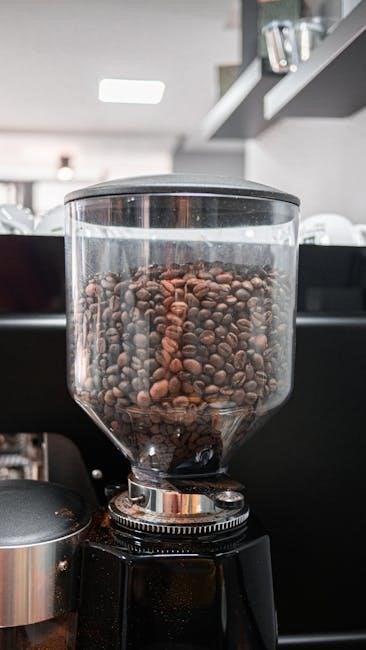
Brewing Methods and Grind Size
Different brewing methods require specific grind sizes. Espresso needs a fine grind‚ pour-over medium to fine‚ and French press coarse. Proper size ensures better extraction and flavor.
Espresso: Fine Grind Requirements
Espresso demands a fine grind to ensure proper extraction. The grind size should be slightly finer than sand‚ allowing pressurized hot water to flow evenly. A burr grinder is ideal for achieving consistent particle size. Adjusting the grind setting is crucial‚ as even small changes can impact the shot’s quality. Over-extraction or under-extraction can occur if the grind is too fine or too coarse. Regular calibration of your grinder ensures optimal results. Experiment with settings to find the perfect balance for your espresso machine.
Pour-Over: Medium to Fine Grind
The pour-over method requires a medium to fine grind‚ allowing for even extraction. This grind size ensures water flows through the coffee evenly‚ releasing balanced flavors. A burr grinder is ideal for achieving consistency. Adjust the grind slightly finer for a slower drip or coarser for a quicker brew. Experimentation is key to finding your perfect balance. Proper grind size enhances the nuanced flavors of your coffee‚ making each pour-over a delightful experience. Consistency in grind size is crucial for optimal flavor extraction in this manual brewing method.
French Press: Coarse Grind
A French Press requires a coarse grind to ensure proper immersion brewing. The coarse texture allows for even extraction without over-extracting‚ as the coffee grounds steep in hot water. A grind size similar to kosher salt or breadcrumbs is ideal. This method highlights the coffee’s bold and rich flavors. If the grind is too fine‚ it can lead to a muddy texture and over-extraction. Adjusting the grind coarseness can help achieve the perfect balance for a smooth‚ full-bodied cup. Experimenting with the grind size can refine the brewing process for optimal flavor.
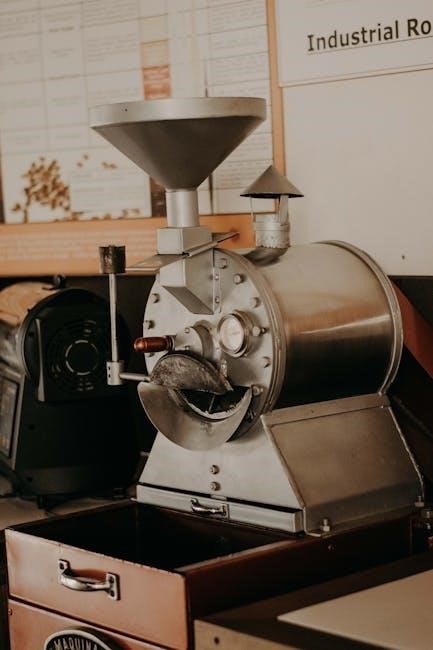
Adjusting Your Grinder
Adjusting your grinder involves turning the dial or moving burrs to achieve the perfect grind size. Calibrate regularly to ensure consistency and optimal extraction for every brew method.
How to Calibrate Your Grinder for Optimal Results
Calibrating your grinder ensures precise grind sizes‚ crucial for extraction. Start by adjusting settings based on your brewing method—fine for espresso‚ medium for pour-over‚ or coarse for French Press. Use a scale to measure coffee and grind uniformly. Clean the grinder before calibration to avoid residue. Test the grind consistency and tweak settings in small increments. Regular recalibration maintains accuracy‚ especially after changing coffee beans or brewing methods.
Tips for Adjusting Grind Settings
Start with small adjustments to avoid over-compensating. Use a scale for precise measurements and refer to your grinder’s built-in guides. Test a small batch before brewing to ensure the grind size suits your method. For espresso‚ aim for a fine grind‚ while pour-over requires a medium setting. Clean the grinder regularly to prevent residue from affecting consistency. Experiment with time-based grinding for precision‚ as seen in models like the Smart Grinder Pro. Adjusting grind settings is a process of trial and error‚ but patience leads to the perfect brew.
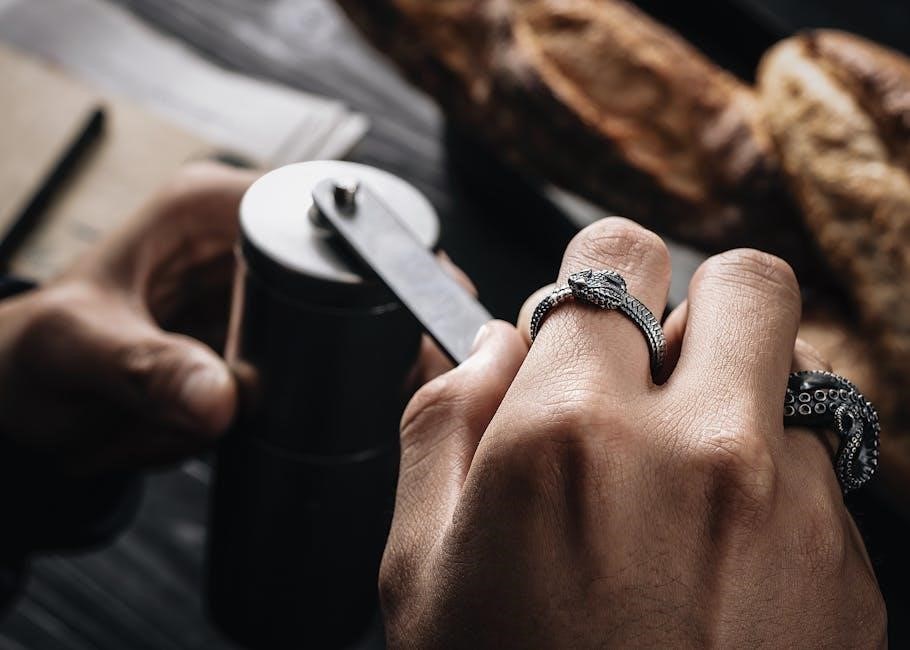
Maintenance and Care
Regular cleaning prevents oil buildup and preserves flavor. Descale and lubricate grinding mechanisms as needed. Replace burrs periodically to maintain sharpness and consistent grind quality.
Cleaning Your Coffee Grinder Regularly
Cleaning your coffee grinder is essential to maintain freshness and prevent old coffee oils from affecting the flavor. Use a soft brush or a small vacuum to remove loose grounds. For deeper cleaning‚ wipe the interior with a damp cloth and let it dry thoroughly. Avoid harsh chemicals‚ as they can leave residues. Grind uncooked rice or coffee beans to absorb odors and oils‚ then discard. Regular cleaning ensures consistent grind quality and prevents clogs.
For burr grinders‚ check and replace worn burrs periodically to maintain sharpness and even grinding. Clean after every use for optimal performance.
When to Replace Grinder Burrs
Grinder burrs should be replaced when they show signs of wear‚ such as uneven grinding or a whistling noise during operation. Dull burrs can lead to inconsistent particle sizes‚ affecting flavor extraction. If you notice your coffee tasting stale or over-extracted‚ it may be time to replace them. Typically‚ burrs need replacement every 1-3 years‚ depending on usage and grinder type. Regular use can cause metal burrs to dull faster‚ while ceramic burrs may last longer but still require eventual replacement to maintain grind quality and prevent mechanical issues.
Troubleshooting Common Issues
Identify and resolve grinder problems like inconsistent grinds or jams by cleaning‚ checking for blockages‚ or adjusting settings to ensure smooth operation and consistent results.
Dealing with Inconsistent Grinds
Inconsistent grinds can ruin a perfect brew. They often result from worn burrs‚ incorrect grind settings‚ or uneven bean feeding. To fix this‚ calibrate your grinder regularly and ensure burrs are sharp. Adjust the grind setting slightly and test the results. Clean the grinder to remove old coffee residue‚ which can cause clumping. Using freshly roasted beans also helps‚ as stale beans may not grind evenly. For blade grinders‚ pulse grinding can improve consistency. Proper maintenance and adjustment are key to achieving uniform grinds every time.
Fixing a Jammed Grinder
If your grinder jams‚ turn it off and unplug it. Check for blockages like large beans or debris. Use a soft brush to gently clean the grinding chamber. If the issue persists‚ adjust the grind setting to a coarser size. Ensure the hopper is not overfilled‚ as this can cause jams. Regularly cleaning and maintaining your grinder prevents such issues. If the problem continues‚ worn burrs may need replacement. Always refer to the manufacturer’s guidelines for specific troubleshooting steps.

Advanced Grinding Techniques
Explore advanced methods like pre-infusion and bloom for enhanced flavor. Time-based grinding ensures precision‚ optimizing extraction for a perfect brew every time.
Pre-Infusion and bloom: Enhancing Flavor
Pre-Infusion and Bloom: Enhancing Flavor
Pre-infusion involves soaking coffee grounds before brewing to release trapped gases‚ enhancing flavor. This step ensures even extraction and prevents channeling. The bloom phase‚ typically lasting 15-20 seconds‚ allows the coffee to expand‚ releasing its aromatic compounds. Grind size plays a role here‚ as a coarser grind may require a longer pre-infusion time. Adjusting grind settings can optimize this process‚ leading to a more balanced and flavorful cup. Time-based grinding techniques can help perfect this step‚ ensuring precision and consistency in every brew.
Time-Based Grinding for Precision
Time-based grinding allows for precise control over the amount of coffee ground‚ ensuring consistent extraction. By timing the grind‚ you can achieve uniform particle distribution‚ which is crucial for methods like pour-over or Aeropress. This technique‚ often used with smart grinders‚ enables you to adjust grind duration for the perfect dose. For example‚ a 15-20 second pre-infusion followed by a 40-second brew time ensures balanced flavor. Time-based grinding enhances precision‚ making it easier to experiment with different roast levels and brewing techniques for a tailored coffee experience;
The Future of Coffee Grinding
The future of coffee grinding lies in smart technology and AI integration‚ offering precise control and eco-friendly solutions for coffee enthusiasts and professionals alike.
Smart Grinders and Technology Integration
Smart grinders are revolutionizing coffee grinding with Wi-Fi connectivity and smartphone app controls‚ allowing precise adjustments and scheduling. These grinders integrate AI to optimize grind size based on brewing methods‚ ensuring consistency. Brands like Breville offer models with LCD displays for customization. Google’s AI trials with companies like Grind highlight how technology enhances efficiency and personalization in coffee preparation. This integration not only streamlines the process but also elevates the overall coffee experience‚ making it accessible to both novices and enthusiasts. The future of grinding is undeniably linked to smart technology and innovation.
Sustainable Practices in Coffee Grinding
Adopting eco-friendly habits in coffee grinding can make a significant impact. Opt for locally roasted‚ ethically sourced beans to reduce carbon footprint. Choose energy-efficient grinders or manual options to minimize power use. Regularly cleaning and maintaining your grinder extends its lifespan‚ reducing waste. Consider brands with sustainable practices‚ like Certified B Corps‚ and repair or repurpose old equipment. Supporting small roasters and reducing bean transportation also promotes environmental sustainability. Embrace these practices to enjoy great coffee while contributing to a greener planet and fostering ethical consumption.
Mastering coffee grinding enhances your brewing experience‚ ensuring consistency and flavor. With practice and the right tools‚ you can elevate your coffee game and explore future innovations.
Mastering the Art of Coffee Grinding
Mastering coffee grinding is a balance of art and science‚ requiring precision and practice. Consistent grind size ensures even extraction‚ while understanding your grinder’s capabilities enhances flavor. Calibration is key to achieving the perfect grind‚ and regular maintenance keeps your grinder performing at its best. From fine espresso grinds to coarse French press textures‚ each brew method demands a specific consistency. By refining your technique and staying attentive to details‚ you can unlock the full potential of your coffee beans and elevate your brewing experience to new heights.
Leave a Reply
You must be logged in to post a comment.